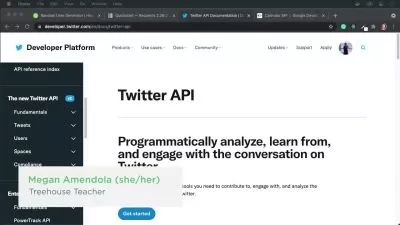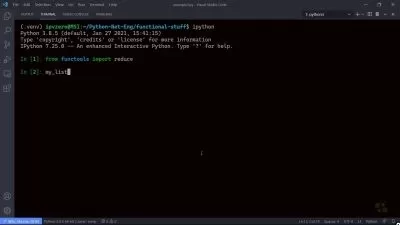XML, XSLT and XPath Essential Course
H Academy
1:59:05
Description
Learn XML programming and we will also investigate XML technologies like XPath and XSLT.
What You'll Learn?
- You will learn XML XSLT and XPath in detail
- You will also learn the basic rules of XML
- You will be able to learn how to manipulate XML content using XPath and XSLT
- You will also covers what you need to know to not only get started with XML, but also master it
- You will also learn advantages and disadvantages of XML
- You will also learn different types of XML content
- You will also learn Document Object Model (DOM)
- and much more
Who is this for?
More details
DescriptionWelcome guys in this course I will be your instructor. In this course I will talk straight to the point. Therefore, we will cover more in less time.
I tried my best to make this course compact and valuable. Because lots of people don't have enough time to watch lengthy courses. So, if you are one of those then this is perfect course for you.
Now mostly courses about XML XSLT and XPath are too long and I have noticed that when someone is taking long course. He forget lot of things in-between. So, I tried my best to make this course compact and precise.
XML has become a widely-used standard for storing and exchanging information on the Internet and for building mobile applications.
XML (Extensible Markup Language) is a markup language similar to HTML, but without predefined tags to use. Instead, you define your own tags designed specifically for your needs. This is a powerful way to store data in a format that can be stored, searched, and shared.
What is XML used for?
XML (Extensible Markup Language) is used to describe data. The XML standard is a flexible way to create information formats and electronically share structured data via the public internet, as well as via corporate networks.
Knowing how to work with XML has become a core skill that every developer needs to have. In this course we'll start off by learning about what XML is and does and some of its advantages and drawbacks.
Then we'll see how to create and style XML content using a variety of approaches such as CSS and using the browser's DOM. We'll investigate complementary XML technologies like XPATH and XSLT and see how they can be used to manipulate XML content.
XML is used extensively in today's online world – banking services, online retail stores, integrating industrial systems, among other things. Create interactive web pages, store and render content data to the user based on processing logic using the XSLT processor.
Whether it's working behind the scenes of publishing blogs, distributing data over the Web, or bridging the gaps between separate computer systems, XML is a foundational technology that every developer needs to know.
When you're finished with this course, you'll be able to immediately put XML to use.
I invite you to join me on this XML journey.
Let's get started.
Thank you.
Who this course is for:
- Who wants to learn XML XSLT and XPath
- Developer, Programmers, Analysts
- Students, who wants to learn XML, XSLT, XPath
- Anyone who is interested in mobile development
- Front-end and Back-end web developers
Welcome guys in this course I will be your instructor. In this course I will talk straight to the point. Therefore, we will cover more in less time.
I tried my best to make this course compact and valuable. Because lots of people don't have enough time to watch lengthy courses. So, if you are one of those then this is perfect course for you.
Now mostly courses about XML XSLT and XPath are too long and I have noticed that when someone is taking long course. He forget lot of things in-between. So, I tried my best to make this course compact and precise.
XML has become a widely-used standard for storing and exchanging information on the Internet and for building mobile applications.
XML (Extensible Markup Language) is a markup language similar to HTML, but without predefined tags to use. Instead, you define your own tags designed specifically for your needs. This is a powerful way to store data in a format that can be stored, searched, and shared.
What is XML used for?
XML (Extensible Markup Language) is used to describe data. The XML standard is a flexible way to create information formats and electronically share structured data via the public internet, as well as via corporate networks.
Knowing how to work with XML has become a core skill that every developer needs to have. In this course we'll start off by learning about what XML is and does and some of its advantages and drawbacks.
Then we'll see how to create and style XML content using a variety of approaches such as CSS and using the browser's DOM. We'll investigate complementary XML technologies like XPATH and XSLT and see how they can be used to manipulate XML content.
XML is used extensively in today's online world – banking services, online retail stores, integrating industrial systems, among other things. Create interactive web pages, store and render content data to the user based on processing logic using the XSLT processor.
Whether it's working behind the scenes of publishing blogs, distributing data over the Web, or bridging the gaps between separate computer systems, XML is a foundational technology that every developer needs to know.
When you're finished with this course, you'll be able to immediately put XML to use.
I invite you to join me on this XML journey.
Let's get started.
Thank you.
Who this course is for:
- Who wants to learn XML XSLT and XPath
- Developer, Programmers, Analysts
- Students, who wants to learn XML, XSLT, XPath
- Anyone who is interested in mobile development
- Front-end and Back-end web developers
User Reviews
Rating
H Academy
Instructor's Courses
Udemy
View courses Udemy- language english
- Training sessions 22
- duration 1:59:05
- Release Date 2023/02/22










